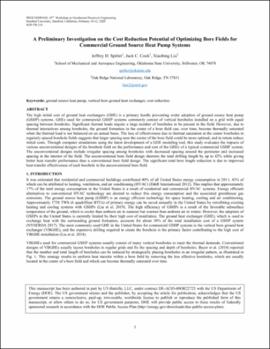| dc.contributor.author | Spitler, Jeffrey D. | |
| dc.contributor.author | Cook, Jack C. | |
| dc.contributor.author | Liu, Xiaobing | |
| dc.date.accessioned | 2022-04-26T18:35:39Z | |
| dc.date.available | 2022-04-26T18:35:39Z | |
| dc.date.issued | 2020-02-10 | |
| dc.identifier | oksd_spitler_preliminaryinvestigation_2020 | |
| dc.identifier.citation | Spitler, J. D., Cook, J. C., & Liu, X. (2020). A preliminary investigation on the cost reduction potential of optimizing bore fields for commercial ground source heat pump systems. Paper presented and published in Proceedings of the 45th Workshop on Geothermal Reservoir Engineering, Stanford University, Stanford, CA. February 10-12, 2020. | |
| dc.identifier.uri | https://hdl.handle.net/11244/335284 | |
| dc.description.abstract | The high initial cost of ground heat exchangers (GHE) is a primary hurdle preventing wider adoption of ground source heat pump (GSHP) systems. GHEs used for commercial GSHP systems commonly consist of vertical boreholes installed on a grid with equal spacing between boreholes. Significant thermal loads require a large number of boreholes to be present in the field. However, due to thermal interactions among boreholes, the ground formation in the center of a bore field can, over time, become thermally saturated when the thermal load is not balanced on an annual basis. The loss of effectiveness due to thermal saturation at the center boreholes in regularly spaced borehole fields suggests that larger spacing near the center of the bore field could be more optimal, and in return reduce initial costs. Through computer simulations using the latest development of a GHE modeling tool, this study evaluates the impacts of various unconventional designs of the borehole field on the performance and cost of the GHEs of a typical commercial GSHP system. The unconventional designs include irregular spacing among boreholes with decreased spacing around the perimeter and increased spacing in the interior of the field. The unconventional bore field design shortens the total drilling length by up to 42% while giving better heat transfer performance than a conventional bore field design. The significant total bore length reduction is due to improved heat transfer effectiveness of each borehole in the unconventional bore field. | |
| dc.format | application/pdf | |
| dc.language | en_US | |
| dc.publisher | Stanford Geothermal Program | |
| dc.rights | This material has been previously published. In the Oklahoma State University Library's institutional repository this version is made available through the open access principles and the terms of agreement/consent between the author(s) and the publisher. The permission policy on the use, reproduction or distribution of the material falls under fair use for educational, scholarship, and research purposes. Contact Digital Resources and Discovery Services at lib-dls@okstate.edu or 405-744-9161 for further information. | |
| dc.title | Preliminary investigation on the cost reduction potential of optimizing bore fields for commercial ground source heat pump systems | |
| osu.filename | oksd_spitler_preliminaryinvestigation_2020.pdf | |
| dc.description.department | Mechanical and Aerospace Engineering | |
| dc.type.genre | Conference proceedings | |
| dc.type.material | Text | |
| dc.subject.keywords | ground source heat pump | |
| dc.subject.keywords | vertical bore ground heat exchanger | |
| dc.subject.keywords | cost reduction | |
| osu.authorOrcid.uri | ORCID: 0000-0003-0826-0512 (Spitler, JD) | |
